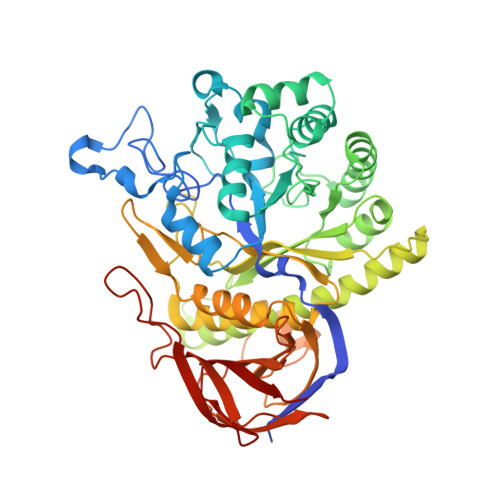Structure and function characterization of the alpha-L-arabinofuranosidase from the white-rot fungus Trametes hirsuta.
Si, Z., Cai, Y., Zhao, L., Han, L., Wang, F., Yang, X., Gao, X., Lu, M., Liu, W.(2023) Appl Microbiol Biotechnol 107: 3967-3981
- PubMed: 37178306
- DOI: https://doi.org/10.1007/s00253-023-12561-w
- Primary Citation of Related Structures:
8I0A - PubMed Abstract:
α-L-Arabinofuranosidases (Abfs) play a crucial role in the degradation of hemicelluloses, especially arabinoxylans (AX). Most of the available characterized Abfs are from bacteria, while fungi, as natural decomposers, contain Abfs with little attention given. An arabinofuranosidase (ThAbf1), belonging to the glycoside hydrolase 51 (GH51) family, from the genome of the white-rot fungus Trametes hirsuta, was recombinantly expressed, characterized, and functionally determined. The general biochemical properties showed that the optimal conditions for ThAbf1 were pH 6.0 and 50°C. In substrate kinetics assays, ThAbf1 preferred small fragment arabinoxylo-oligosaccharides (AXOS) and could surprisingly hydrolyze di-substituted 2 3 ,3 3 -di-L-arabinofuranosyl-xylotriose (A 2,3 XX). It also synergized with commercial xylanase (XYL) and increased the saccharification efficiency of arabinoxylan. The crystal structure of ThAbf1 indicated the presence of an adjacent cavity next to the catalytic pocket which led to the ability of ThAbf1 to degrade di-substituted AXOS. The narrow binding pocket prevents ThAbf1 from binding larger substrates. These findings have strengthened our understanding of the catalytic mechanism of GH51 family Abfs and provided a theoretical foundation for the development of more efficient and versatile Abfs to accelerate the degradation and biotransformation of hemicellulose in biomass. KEY POINTS: • ThAbf1 from Trametes hirsuta degraded di-substituted arabinoxylo-oligosaccharide. • ThAbf1 performed detailed biochemical characterization and kinetics. • ThAbf1 structure has been obtained to illustrate the substrate specificity.
- Jiangsu Key Laboratory of Druggability of Biopharmaceuticals, State Key Laboratory of Natural Medicines, College of Life Science and Technology, China Pharmaceutical University, Nanjing, 210009, PR China.
Organizational Affiliation:
















